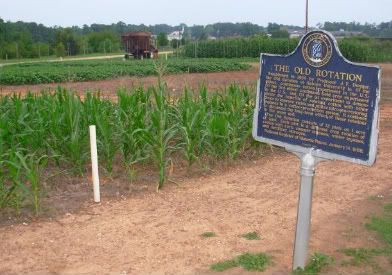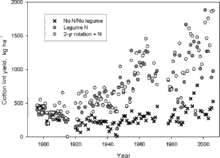Experiment demonstrates 110 years of sustainable agriculture

In 1896, Professor J.F. Duggar at the Agricultural and Mechanical College of Alabama (now Auburn University) started an experiment to test his theories that sustainable cotton production was possible on Alabama soils if growers would use crop rotation and include winter legumes (clovers and/or vetch) to protect the soil from winter erosion.
Today, his experiment on the campus of Auburn University is the oldest, continuous cotton experiment in the world and the third oldest field crop experiment in the United States on the same site. The experiment, known as “the Old Rotation,” has continued with only slight modifications in treatments and was placed on the National Register of Historical Places in 1988.
Researchers at Auburn University and at USDA-Soil Dynamics Laboratory in Auburn, AL, have prepared the first ever comprehensive research publication covering the entire 110-yr history of this experiment. It was published in the September-October issue of Agronomy Journal, and provides insight into issues both past and present that effect sustainable crop production in the South.
The thirteen plots in the Old Rotation include (i) continuous cotton, (ii) a 2-yr rotation of cotton with corn, and (iii) a 3-year rotation of cotton-corn-wheat-soybean. These crop rotations include treatments with and without winter legumes (usually crimson clover and/or vetch) and with and without fertilizer nitrogen.
 After more than 110 years, the Old Rotation continues to document the long-term effects of crop rotation and winter legumes on cotton production in the Deep South (graph, click to enlarge). It provides growers, students, and faculty with a living demonstration of fundamental agronomic practices that result in sustainable crop production. Long-term yields indicate that winter legumes are as effective as nitrogen fertilizer in producing non-irrigated, 10-yr average cotton yields of 1,100 pounds lint per acre. Winter legumes and crop rotations contribute to increased soil organic matter. Higher soil organic matter results in higher crop yields:
After more than 110 years, the Old Rotation continues to document the long-term effects of crop rotation and winter legumes on cotton production in the Deep South (graph, click to enlarge). It provides growers, students, and faculty with a living demonstration of fundamental agronomic practices that result in sustainable crop production. Long-term yields indicate that winter legumes are as effective as nitrogen fertilizer in producing non-irrigated, 10-yr average cotton yields of 1,100 pounds lint per acre. Winter legumes and crop rotations contribute to increased soil organic matter. Higher soil organic matter results in higher crop yields: energy ::biomass :: bioenergy :: agriculture :: crop rotation :: nitrogen :: fertilizer :: soil organic matter :: sustainability ::
energy ::biomass :: bioenergy :: agriculture :: crop rotation :: nitrogen :: fertilizer :: soil organic matter :: sustainability :: In 1997, the Old Rotation entered a new era of agricultural production where boll weevil eradication, genetically modified crops, and conservation tillage almost eliminated the need for the plow and pesticides.
In 2003, irrigation was added to half of each plot. Yields of cotton, corn, wheat and soybean continue to increase far beyond the yields of Professor Duggar’s generation.
Since initiating conservation tillage practices in 1997, all-time, non-irrigated record yields have been made on all the crops grown on the Old Rotation: 1,710 pounds cotton lint per acre in 2006, 95 bushels wheat per acre in 2001, 236 bushels corn per acre in 1999, and 67 bushels of double-cropped soybean per acre in 1997 after wheat.
Figure: Annual cotton lint yields for the no-N and no-legume treatment (Plot 6), the continuous cotton with only legume N treatment (Plot 8), and the 2-yr rotation + N treatment (Plots 5 and 9).
References:
Charles C. Mitchella, Dennis P. Delaneya and Kipling S. Balkcomb, "A Historical Summary of Alabama's Old Rotation (circa 1896): The World's Oldest, Continuous Cotton Experiment", Agronomy Journal 100:1493-1498, 8 September 2008, DOI: 10.2134/agronj2007.0395
 --------------
--------------
 Mongabay, a leading resource for news and perspectives on environmental and conservation issues related to the tropics, has launched Tropical Conservation Science - a new, open access academic e-journal. It will cover a wide variety of scientific and social studies on tropical ecosystems, their biodiversity and the threats posed to them.
Mongabay, a leading resource for news and perspectives on environmental and conservation issues related to the tropics, has launched Tropical Conservation Science - a new, open access academic e-journal. It will cover a wide variety of scientific and social studies on tropical ecosystems, their biodiversity and the threats posed to them.









0 Comments:
Post a Comment
Links to this post:
Create a Link
<< Home